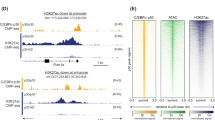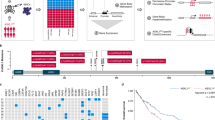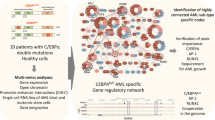Abstract
E26 transforming sequence-related gene (ERG) is a transcription factor involved in normal hematopoiesis and is dysregulated in leukemia. ERG mRNA overexpression was associated with poor prognosis in a subset of patients with T-cell acute lymphoblastic leukemia (T-ALL) and acute myeloid leukemia (AML). Herein, a genome-wide screen of ERG target genes was conducted by chromatin immunoprecipitation-on-chip (ChIP-chip) in Jurkat cells. In this screen, 342 significant annotated genes were derived from this global approach. Notably, ERG-enriched targets included WNT signaling genes: WNT11, WNT2, WNT9A, CCND1 and FZD7. Furthermore, chromatin immunoprecipitation (ChIP) of normal and primary leukemia bone marrow material also confirmed WNT11 as a target of ERG in six of seven patient samples. A larger sampling of patient diagnostic material revealed that ERG and WNT11 mRNA were co-expressed in 80% of AML (n=30) and 40% in T-ALL (n=30) bone marrow samples. Small interfering RNA (siRNA)-mediated knockdown of ERG confirmed downregulation of WNT11 transcripts. Conversely, in a tet-on ERG-inducible assay, WNT11 transcripts were co-stimulated. A WNT pathway agonist, 6-bromoindirubin-3-oxime (BIO), was used to determine the effect of cell growth on the ERG-inducible cells. The addition of BIO resulted in an ERG-dependent proliferative growth advantage over ERG-uninduced cells. Finally, ERG induction prompted morphological transformation whereby round unpolarized K562 cells developed elongated protrusions and became polarized. This morphological transformation could effectively be inhibited with BIO and with siRNA knockdown of WNT11. In conclusion, ERG transcriptional networks in leukemia converge on WNT signaling targets. Specifically, WNT11 emerged as a direct target of ERG. Potent ERG induction promoted morphological transformation through WNT11 signals. The findings in this study unravel new ERG-directed molecular signals that may contribute to the resistance of current therapies in acute leukemia patients with poor prognosis characterized by high ERG mRNA expression.
This is a preview of subscription content, access via your institution
Access options
Subscribe to this journal
Receive 50 print issues and online access
$259.00 per year
only $5.18 per issue
Buy this article
- Purchase on Springer Link
- Instant access to full article PDF
Prices may be subject to local taxes which are calculated during checkout






Similar content being viewed by others
Accession codes
References
Anderson MK, Hernandez-Hoyos G, Diamond RA, Rothenberg EV . (1999). Precise developmental regulation of Ets family transcription factors during specification and commitment to the T cell lineage. Development 126: 3131–3148.
Anton R, Kestler HA, Kestler HA, Kühl M . (2007). Beta-catenin signaling contributes to stemness and regulates early differentiation in murine embryonic stem cells. FEBS Lett 581: 5247–5254.
Baldus C, Burmeister T, Martus P, Schwartz S, Gökbuget N, Bloomfield CD et al. (2006). High expression of the ETS transcription factor ERG predicts adverse outcome in acute T-lymphoblastic leukemia in adults. J Clin Oncol 24: 4714–4720.
Baldus CD, Liyanarachchi S, Mrózek K, Auer H, Tanner SM, Guimond M et al. (2004). Acute myeloid leukemia with complex karyotypes and abnormal chromosome 21: amplification discloses overexpression of APP, ETS2, and ERG genes. Proc Natl Acad Sci USA 101: 3915–3920.
Baldus CD, Mrózek K, Marcucci G, Bloomfield CD . (2007). Clinical outcome of de novo acute myeloid leukaemia patients with normal cytogenetics is affected by molecular genetic alterations: a concise review. Br J Haematol 137: 387–400.
Bastian LS, Yagi M, Chan C, Roth GJ . (1996). Analysis of the megakaryocyte glycoprotein IX promoter identifies positive and negative regulatory domains and functional GATA and Ets sites. J Biol Chem 271: 18554–18560.
Bikkavilli RK, Feigin ME, Malbon CC . (2008). p38 mitogen-activated protein kinase regulates canonical Wnt-beta-catenin signaling by inactivation of GSK3beta. J Cell Sci 121: 3598–3607.
Birdsey GM, Dryden NH, Amsellem V, Gebhardt F, Sahnan K, Haskard DO et al. (2008). Transcription factor Erg regulates angiogenesis and endothelial apoptosis through VE-cadherin. Blood 111: 3498–3506.
Bohne A, Schlee C, Mossner M, Thibaut J, Heesch S, Thiel E et al. (2009). Epigenetic control of differential expression of specific ERG isoforms in acute T-lymphoblastic leukemia. Leuk Res 33: 817–812.
Brandon C, Eisenberg LM, Eisenberg CA . (2000). WNT signaling modulates the diversification of hematopoietic cells. Blood 96: 4132–4141.
Chiang J, Majeti R, Becker MW, Tian Q, Lee TL, Yan X et al. (2009). Dysregulated gene expression networks in human acute myelogenous leukemia stem cells. Proc Natl Acad Sci USA 106: 3396–3401.
Dennis GJ, Sherman BT, Hosack DA, Yang J, Gao W, Lane HC et al. (2003). DAVID: database for annotation, visualization, and integrated discovery. Genome Biol 4: 3.
Eisenberg CA, Gourdie RG, Eisenberg LM . (1997). Wnt-11 is expressed in early avian mesoderm and required for the differentiation of the quail mesoderm cell line QCE-6. Development 124: 525–536.
Ellett F, Kile BT, Lieschke GJ . (2009). The role of the ETS factor erg in zebrafish vasculogenesis. Mech Dev 126: 220–229.
Farnham PJ . (2009). Insights from genomic profiling of transcription factors. Nat Rev Genet 10: 605–616.
Flaherty MP, Dawn B . (2008). Noncanonical Wnt11 signaling and cardiomyogenic differentiation. Trend Cardiovas Med 18: 260–268.
Gomez-Roman J, Cordeu L, Agirre X, Jiménez-Velasco A, San José-Eneriz E, Garate L et al. (2007). Epigenetic regulation of Wnt-signaling pathway in acute lymphoblastic leukemia. Blood 109: 3462–3469.
Guenther MG, Levine SS, Boyer LA, Jaenisch R, Young RA . (2007). A chromatin landmark and transcription initiation at most promoters in human cells. Cell 130: 77–88.
Gupta S, Iljin K, Sara H, Mpindi JP, Mirtti T, Vainio P et al. (2010). FZD4 as a mediator of ERG oncogene—induced WNT signaling and epithelial-to-mesenchymal transition in human prostate cancer cells. Cancer Res 70: 6735–6745.
Holmes T, O′Brien TA, Knight R, Lindeman R, Shen S, Song E et al. (2008). Glycogen synthase kinase-3beta inhibition preserves hematopoietic stem cell activity and inhibits leukemic cell growth. Stem Cells 26: 1288–1297.
Hu D, Bi X, Fang W, Han A, Yang W . (2009). GSK3beta is involved in JNK2-mediated beta-catenin inhibition. PloS One 4: e6640.
Huang DW, Sherman BT, Lempicki RA . (2009). Systematic and integrative analysis of large gene lists using DAVID bioinformatics resources. Nat Prot 4: 44–57.
Iwamoto M, Tamamura Y, Koyama E, Komori T, Takeshita N, Williams JA et al. (2007). Transcription factor ERG and joint and articular cartilage formation during mouse limb and spine skeletogenesis. Dev Biol 305: 40–51.
Klezovitch O, Risk M, Coleman I, Lucas JM, Null M, True LD et al. (2008). A causal role for ERG in neoplastic transformation of prostate epithelium. Proc Natl Acad Sci USA 105: 2105–2110.
Kong XT, Ida K, Ichikawa H, Shimizu K, Ohki M, Maseki N et al. (1997). Consistent detection of TLS/FUS-ERG chimeric transcripts in acute myeloid leukemia with t(16;21)(p11;q22) and identification of a novel transcript. Blood 90: 1192–1199.
Lai S, Chien AJ, Moon RT . (2009). Wnt/Fz signaling and the cytoskeleton: potential roles in tumorigenesis. Cell Res 19: 532–545.
Lelinek J, Kuang S, Tong W, Yang H, Lin W, Lee MK et al. (2008). Genome-wide identification of aberrantly methylated promoter associated CpG islands in acute lymphocytic leukemia. Leukemia 22: 1529–1538.
Lin Z, Reierstad S, Huang C, Bulun SE . (2007). Novel estrogen receptor-alpha binding sites and estradiol target genes identified by chromatin immunoprecipitation cloning in breast cancer. Cancer Res 67: 5017–5024.
Look A, O′Neil J . (2007). Mechanisms of transcription factor deregulation in lymphoid cell transformation. Oncogene 26: 6838–6849.
Loughran SJ, Kruse EA, Hacking DF, de Graaf CA, Hyland CD, Willson TA et al. (2008). The transcription factor Erg is essential for definitive hematopoiesis and the function of adult hematopoietic stem cells. Nat Immunol 9: 810–819.
Luo J . (2009). Glycogen synthase kinase 3beta (GSK-3b) in tumorigenesis and cancer chemotherapy. Cancer Lett 273: 194–200.
Marcucci G, Baldus CD, Ruppert AS, Whitman SP, Archer KJ, Marcucci G et al. (2005). Overexpression of the ETS-related gene, ERG, predicts a worse outcome in acute myeloid leukemia with normal karyotype: cancer and leukemia Group B study. J Clin Oncol 23: 9234–9242.
Martin V, Valencia A, Agirre X, Cervera J, San Jose-Eneriz E, Vilas-Zornoza A et al. (2009). Epigenetic regulation of the non-canonical Wnt pathway in acute myeloid leukemia. Cancer Sci 3: 1–8.
Narod S, Seth A, Nam R . (2008). Fusion in the ETS gene family and prostate cancer. Br J Cancer 99: 847–851.
Rainis L, Toki T, Pimanda JE, Rosenthal E, Machol K, Strehl S et al. (2005). The proto-oncogene ERG in megakaryoblastic leukemias. Cancer Res 65: 7596–7602.
Reya T, Clevers H . (2005). Wnt signalling in stem cells and cancer. Nature 434: 843–850.
Salek-Ardakani S, Smooha G, De Boer J, Sebire NJ, Morrow M, Rainis L et al. (2009). ERG is a megakaryocytic oncogene. Cancer Res 69: 4665–4673.
Sato N, Meijer L, Skaltsounis L, Greengard P, Brivanlou AH . (2004). Maintenance of pluripotency in human and mouse embryonic stem cells through activation of Wnt signaling by a pharmacological GSK-3-specific inhibitor. Nat Med 10: 55–63.
Sharrocks AD . (2001). The Ets-domain transcription factor family. Nat Rev Mol Cell Biol 2: 827–837.
Shu J, Jelinek J, Chang H, Shen L, Qin T, Chung W et al. (2006). Silencing of bidirectional promoters by DNA methylation in tumorigenesis. Cancer Res 66: 5077–5084.
Singla DK, Schneider DJ, LeWinter MM, Sobel BE . (2006). Wnt3a But Not Wnt11 supports self-renewal of embryonic stem cells. Biochem Biophys Res Commun 345: 789–795.
Soda M, Willert K, Kaushansky K, Geddis AE . (2008). Inhibition of GSK-3beta promotes survival and proliferation of megakaryocytic cells through a beta-catenin-independent pathway. Cellular Signal 20: 2317–2323.
Sorensen PH, Lessnic, Stephen L, Lopez-Terrada D, Liu XF, Triche TJ et al. (1994). A second Ewing's sarcoma translocation, t(21;22), fuses the EWS gene to another ETS-family transcription factor, ERG. Nat Genet 6: 146–151.
Stankiewicz MJ, Crispino JD . (2009). ETS2 and ERG promote megakaryopoiesis and synergize with alterations in GATA-1 to immortalize hematopoietic progenitor cells. Blood 113: 3337–3347.
Tomlins SA, Rhodes DR, Perner S, Dhanasekaran SM, Mehra R, Sun XW et al. (2005). Recurrent fusion of TMPRSS2 and ETS transcription factor genes in prostate cancer. Science 310: 644–648.
Uysal-onganer P, Kawano Y, Caro M, Walker MM, Diez S, Darrington RS et al. (2010). Wnt-11 promotes neuroendocrine-like differentiation, survival and migration of prostate cancer cells. Mol Cancer 9: 55.
Wei G, Badis G, Berger MF, Kivioja T, Palin K, Enge M et al. (2010). Genome-wide analysis of ETS-family DNA-binding in vitro and in vivo. EMBO J 29: 2147–2160.
Wu D, Pan W . (2009). GSK3: a multifaceted kinase in Wnt signaling. Trend Biochem Sci 722: 1–8.
Zhou W, Lin L, Majumdar A, Li X, Zhang X, Liu W et al. (2007). Modulation of morphogenesis by noncanonical Wnt signaling requires ATF/CREB family-mediated transcriptional activation of TGFb. Nat Genet 39: 1225–1234.
Zhu H, Mazor M, Kawano Y, Walker MM, Leung HY, Armstrong K et al. (2004). Analysis of Wnt gene expression in prostate cancer: mutual inhibition by WNT11 and the androgen receptor. Cancer Res 64: 7918–7926.
Acknowledgements
This study was supported by a grant from the Deutsche Krebshilfe (Max Eder Nachwuchsförderung) to CDB. We thank Dr Martin Neumann (Department of Hematology and Oncology, Charité, Berlin, Germany) for his critical reading of the manuscript. We also thank Dr Anja Kühl (Research Center ImmunoSciences, Charité, Berlin, Germany) for helpful advice and fluorescence microscopy assistance.
Author information
Authors and Affiliations
Corresponding author
Ethics declarations
Competing interests
The authors declare no conflict of interest.
Additional information
Supplementary Information accompanies the paper on the Oncogene website
Rights and permissions
About this article
Cite this article
Mochmann, L., Bock, J., Ortiz-Tánchez, J. et al. Genome-wide screen reveals WNT11, a non-canonical WNT gene, as a direct target of ETS transcription factor ERG. Oncogene 30, 2044–2056 (2011). https://doi.org/10.1038/onc.2010.582
Received:
Revised:
Accepted:
Published:
Issue Date:
DOI: https://doi.org/10.1038/onc.2010.582
Keywords
This article is cited by
-
Deep genomic characterization highlights complexities and prognostic markers of pediatric acute myeloid leukemia
Communications Biology (2023)
-
GSK3 inhibitor suppresses cell growth and metabolic process in FLT3-ITD leukemia cells
Medical Oncology (2022)
-
Role of Wnt11 during Osteogenic Differentiation of Human Mesenchymal Stem Cells on Microstructured Titanium Surfaces
Scientific Reports (2018)
-
FAT1 expression and mutations in adult acute lymphoblastic leukemia
Blood Cancer Journal (2014)
-
Clinical significance of Wnt-11 and squamous cell carcinoma antigen expression in cervical cancer
Medical Oncology (2014)



